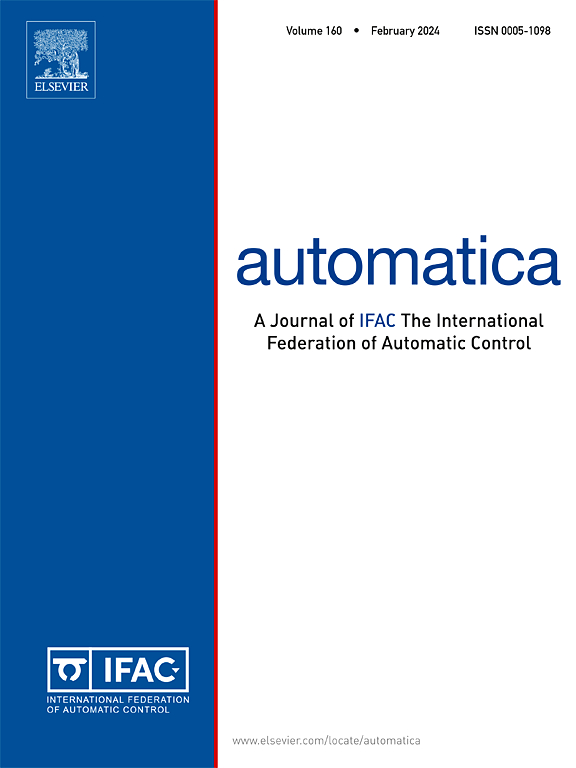一种不需要先验核知识的分布式时延识别算法
IF 4.8
2区 计算机科学
Q1 AUTOMATION & CONTROL SYSTEMS
引用次数: 0
摘要
时滞在工业和自然界中普遍存在,它对瞬态动力学和稳定性都有显著影响。因此,在设计基于模型的控制策略时,通常有必要识别和考虑延迟。然而,识别微分方程中的延迟并不简单,需要专门的方法。此外,现有的识别延迟微分方程(DDEs)中分布时间延迟的方法要求所涉及的核(也称为记忆函数)的函数形式是已知的。在这项工作中,我们提出了一种用于识别分布式延迟的算法,该算法不需要先验的核知识。具体来说,我们1)通过混合Erlang分布的概率密度函数近似DDEs中的未知核,2)使用线性链技巧(LCT)将得到的DDEs转换为ode。最后,将核近似中的参数估计为动态极大似然问题的解,并使用单次射击方法逼近该解。我们用一个涉及熔盐核裂变反应堆点堆动力学模型的数值例子证明了该算法的有效性。本文章由计算机程序翻译,如有差异,请以英文原文为准。
An algorithm for distributed time delay identification without a priori knowledge of the kernel
Time delays are ubiquitous in industry and nature, and they significantly affect both transient dynamics and stability properties. Consequently, it is often necessary to identify and account for the delays when, e.g., designing a model-based control strategy. However, identifying delays in differential equations is not straightforward and requires specialized methods. Furthermore, existing approaches for identifying distributed time delays in delay differential equations (DDEs) require that the functional form of the involved kernel (also called memory function) is known. In this work, we propose an algorithm for identifying distributed delays, which does not require a priori knowledge of the kernel. Specifically, we 1) approximate the unknown kernel in the DDEs by the probability density function of a mixed Erlang distribution and 2) use the linear chain trick (LCT) to transform the resulting DDEs into ODEs. Finally, the parameters in the kernel approximation are estimated as the solution to a dynamical maximum likelihood problem, and we use a single-shooting approach to approximate this solution. We demonstrate the efficacy of the algorithm using a numerical example that involves a point reactor kinetics model of a molten salt nuclear fission reactor.
求助全文
通过发布文献求助,成功后即可免费获取论文全文。
去求助
来源期刊

Automatica
工程技术-工程:电子与电气
CiteScore
10.70
自引率
7.80%
发文量
617
审稿时长
5 months
期刊介绍:
Automatica is a leading archival publication in the field of systems and control. The field encompasses today a broad set of areas and topics, and is thriving not only within itself but also in terms of its impact on other fields, such as communications, computers, biology, energy and economics. Since its inception in 1963, Automatica has kept abreast with the evolution of the field over the years, and has emerged as a leading publication driving the trends in the field.
After being founded in 1963, Automatica became a journal of the International Federation of Automatic Control (IFAC) in 1969. It features a characteristic blend of theoretical and applied papers of archival, lasting value, reporting cutting edge research results by authors across the globe. It features articles in distinct categories, including regular, brief and survey papers, technical communiqués, correspondence items, as well as reviews on published books of interest to the readership. It occasionally publishes special issues on emerging new topics or established mature topics of interest to a broad audience.
Automatica solicits original high-quality contributions in all the categories listed above, and in all areas of systems and control interpreted in a broad sense and evolving constantly. They may be submitted directly to a subject editor or to the Editor-in-Chief if not sure about the subject area. Editorial procedures in place assure careful, fair, and prompt handling of all submitted articles. Accepted papers appear in the journal in the shortest time feasible given production time constraints.
 求助内容:
求助内容: 应助结果提醒方式:
应助结果提醒方式:


